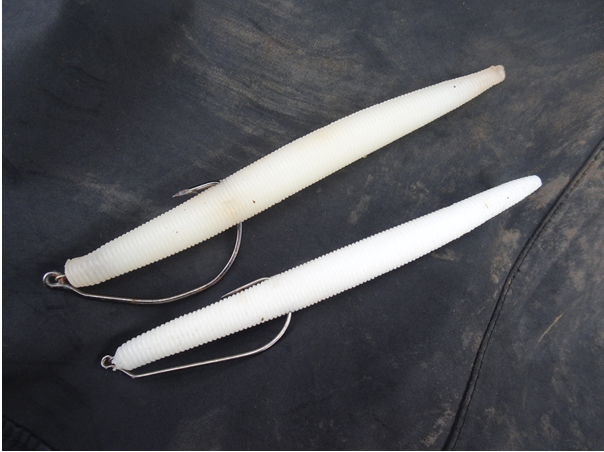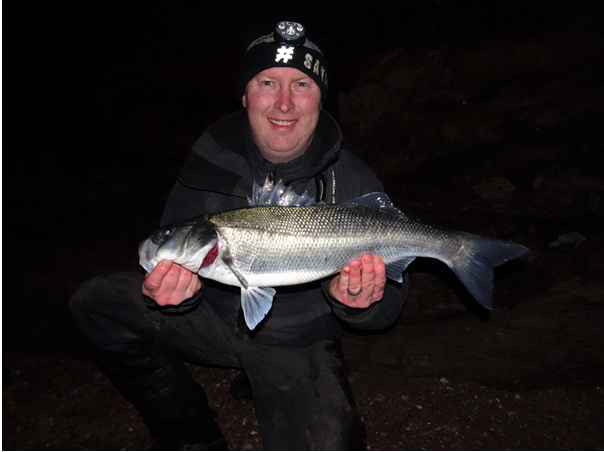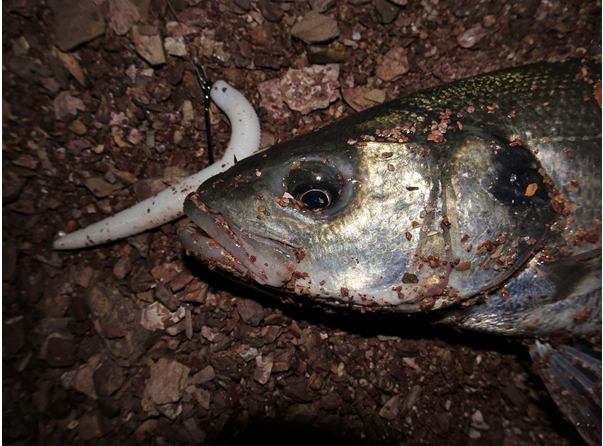What on earth does a bass ‘think’ a white senko actually is?
Posted by Marc Cowling (South Devon Bass Guide) on 25th Jan 2019

I am almost embarrassed thinking back to my first lure caught bass in darkness less than two years ago - embarrassed that I’d never really given it a chance or considered this method worthwhile from a potential guiding perspective years previously!
Yet since that seminal moment a high percentage of the sessions that my clients and I now complete is conducted once the Sun has long since set, for good reason – in my opinion there are simply more bass close inshore at night around most of the marks that I fish. The bass lure I was using on that fateful night, and the one that has accounted for many bass in the past two weeks,is arguably one of the most inconspicuous you can utilise – the humble senko or soft stickbait.
To catch bass here in south Devon in mid-January isn’t entirely unusual, but the nature of their capture during very calm, still nights, primarily during small neap tides when the stars have been reflecting off of the surface in the very shallow water (2-4ft) has really got me thinking about what on earth they (bass) think the lure I am using is...
Shape, Size and Movement
The white senkos/soft stickbaits that I have been using successfully (alongside other lure types without incident) and fished weightless and weedless are the Wave Worm 5” Tiki Bamboo Stick weighing 12g and the 6” Insane Creations Bass Slayer weighing 18g rigged onto a 5/0 Owner Twistlock Weedless hook in the case of the former, and an Eagle Claw Trokar Swimbait Magnum 5/0 when using the latter.

The Insane Creations Bass Slayer (top) and the Wave Worm Tiki Bamboo Stick (bottom) - the lures that the current crop of my bass catches have been achieved on despite also using various other lure types.
Movement... Now here’s the interesting bit, or rather it isn’t that interesting in the sense that all I’m doing is retrieving these innocuous looking lures on a steady retrieve (one full turn of the handle per second) and on a very straight trajectory. Granted, I will angle the cast so that I am always working the lure with the tidal flow/current (rather than against or across it) and on occasion I will allow the lure to drift whilst descending to the seabed before commencing that linear style retrieve. All the senko is doing though is‘ghosting’ along – no rattles and no intrinsic movement.
Why white?
I’m pretty certain that the majority of bass lure anglers who partake in a spot of night fishing will use a white lure at some stage, or indeed exclusively within a session – which in turn means that more bass will be caught on them (in the same way that if they most of us used a pink lure we’d catch more on this colour). But is there something in the reflective properties of a white lure or the way that it quite simply stands out? Could a white lure signal albinism - a creature without camouflage and potentially more obvious, meaning it is vulnerable and therefore susceptible to attack, all of which makes it highly attractive to predators?

The largest of my recent ‘January bass’ measuring 60cm. Did this beauty mistake my lure for what was actively seeking or was it merely reacting to something in its ‘swim’...
What bass want...
In the vast majority of cases I am a firm believer that if you put something in front of a bass that is either looking or acting like something they expect to see, in an environment/circumstance that they expect to find it, then they will hit it – HARD! But without wanting to appear contradictory, herein lies the dilemma – what does a 5-6” ‘worm’ represent and why are they so effective in darkness? I have three theories...
Firstly, the ‘ribbed’ effect on these lures could be transmitting the optimum amount of sound/vibration in the exceptionally tranquil conditions that I tend to fish in darkness – not too obvious, but enough for a bass to ‘home in’ without spooking them. Secondly (and I mention this in my book ‘The Lure of The Bass’) I strongly suspect that a bass’ search image alters in the dark and all manner of tasty critters come to life to perform their own hunting – namely squid and cuttlefish. I don’t think it is beyond the realms of possibility to suspect that something ‘gliding’ through the shallows is indicative of one of these cephalopods, or indeed a sprat or herring travelling (rather than swimming) with the current.
My final hypothesis could be the least complex of all. Could a white senko, whether it is being retrieved or ‘worked’ on the surface (waking), just below, at mid-water level, twitched, drifted, retrieved slowly or quickly not actually be impersonating anything in particular at all! Essentially, is it‘attacked’ by virtue of it ‘just being there’ and within the vicinity of where a marauding pack or lone denizen are or is looming large...
All I know is that is that these lures catch bass – and lots of them! Additionally, sometimes the simplest method can be the most effective!

Marc Cowling is highly regarded bass lure fishing guide based in south Devon.
